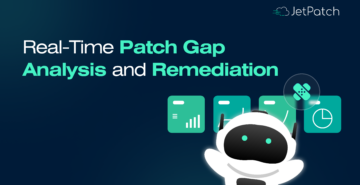Is your IT department lost in the trees? Are you getting so bogged down by the day-to-day that you’re not zooming out and taking a good look at where your organization’s security actually stands?
Where some see only the trees… others are looking out for the entire forest. According to a recent CDW report, modern IT infrastructure is moving beyond the older model of using tech to solve problems. Instead, today’s IT professionals are leveraging insights to add business value.
Sure, you still have to solve day-to-day problems. That aspect of the job is never going away. But with better analytics and smarter use of data, environment-level insights can improve and streamline your overall security and IT operations strategy.
Let’s explore a few benefits of taking a modern, data-centric approach.
Data Analytics Across Industries
As Harvard Business Review points out, the use of data to make decisions is nothing new. What’s remarkable is the quantity of data to which we have access today, as well as our ability to connect the dots.
The first thing to recognize is that using data analytics and taking a higher-level approach isn’t unique to the world of IT. In fact, every industry and department is realizing the benefits of this.
One area where data is making a huge difference is in the shipping industry. Today, this sector has shifted to a fast-moving logistics model that takes a bigger-picture view, using data and technology to pivot nimbly and recover quickly from sudden shifts in the supply chain.
One industry study found that 98% of third-party logistics providers believe “improved, data-driven decision-making is essential to the future success of supply chain activities and processes,” and 86% said, “the effective use of big data will become a core competency of their supply chain organizations.”
UPS, for example, gathers data to track not only the packages themselves but, using telematics sensors in their trucks, other wide-ranging factors pertaining to their vehicles like speed, direction, braking, and drivetrain performance. Adding up all this data and crunching it with today’s modern capabilities adds business value by improving reliability and ensuring on-time delivery wherever possible.
Across all industries, executives are discovering that this type of strategic approach not only creates optimizations at all levels but also scales better, allowing them to leverage a constant stream of insights and anticipate roadblocks.
Data Analytics in IT
Within IT, this data analytics approach has led to the optimization of resources, cost-cutting, and more thorough identification of trends and patterns. For example, analyzing outage data to find workarounds and take preventative steps, identifying areas that need maintenance before problems arise, and creating intelligent plans to respond to network failures.
When it comes to security, a data-based approach usually centers around a recognized high-level security industry framework, such as the NIST Cybersecurity Framework or a more general governance, risk, and compliance (GRC) framework, which, according to an article in CIO Magazine, can lead to “improved decision-making, more optimal IT investments, elimination of silos, and reduced fragmentation among divisions and departments.”
These high-level approaches are focused on the forest, rather than the trees, aligning IT activities to business goals, managing risk, and staying in control of compliance requirements.
What do all these approaches have in common, no matter whether they’re happening in IT, Ops, logistics, or elsewhere in an organization? In general, they all involve shifting focus from being reactive to proactive.
A high-level approach, as we’ve seen here, is about more than just a set of software tools; it’s about frameworks, standards, policies, and procedures that can help make your business stronger overall. So what does this mean for security?
Harvesting Insights
According to CDW’s “The Modern IT Infrastructure Insight Report,” “organizations want their IT investments to do more than keep the lights on.” This means adopting technology not for its own sake but for the sake of driving business improvement.
Today, we need to incorporate the information at our fingertips more intelligently to do things better; we need to work harder with fewer team members and less expense. This will help us achieve a few key business goals:
- Protecting company revenue
- Guarding company and customer data (which means, in turn, building trust and loyalty)
- Optimizing risk management and mitigation
This kind of approach also demands that we consult with major stakeholders. For instance, in healthcare, no security policy should be put in place before consulting with healthcare providers, patients, administrators, and others; this will ensure we have a full understanding of what’s needed to guard personal data, practical workflows, and other details.
While all this is going on, you’re also still solving day-to-day problems. Systems go down, users demand access (or higher-level access), bugs pop up. And it’s essential to not overlook the most basic factors that can impact your business, such as cyber hygiene.
With a forest-focused approach, you need to think about integrating these basic functions into a more global big-picture strategy. In other words, you need to mine these routine day-to-day functions for insights and then analyze them to improve incrementally over time.
And this means you need great tools that can help you leverage these insights to do your job better.
JetPatch Insights
While listening to our customers and helping them deal with day-to-day security issues, the biggest problem they’ve told us about is how hard it is to gather data on security and, specifically, their vulnerability “big picture.”
From those conversations, one clear and pressing need emerged. Every department, we realized, is under pressure to report on performance with specific KPIs, and security is no exception.
From there, our research team invested multiple man-hours to analyze our customers’ environments, coming up with the most important and critical insights to greatly improve their security and accountability.
Finally, around that data, we built JetPatch Insights to give you dynamic insights and intelligence on your security environment and vulnerability remediation, along with tools and tips to repair any problems reported—letting you do your job better and more easily.
With JetPatch Insights, you get clear, easy-to-read reports that show you not only the state of your environment today but also your remediation track record over time, as well as simple tips and suggestions for improvement.
And, of course, even the best intelligent analysis and insights are useless unless they’re direct and clear. So JetPatch Insights gives you crucial reporting that provides immediate business benefits that are:
- Reportable – clear KPIs you can report back on to the C-suite
- Actionable – not just reporting on conditions but recommendations to help you improve
- Understandable – including easy-to-implement tips for streamlining
We’ve created an interface with simplicity in mind, handing you a holistic understanding of your entire environment.
The unique JetPatch approach is to provide two simple primary data views: the “endpoints” perspective to get information on vulnerable assets and the “patches” perspective to provide useful compliance information. We’ve also built-in multiple reports for each perspective, full of insights to help you make better business decisions.
What kind of knowledge can JetPatch Insights provide?
- Patching success rate: Track changes month to month to view upward or downward trends.
- Maintenance times: Compare maintenance window growth/reduction versus previous months.
- Urgent issues: Number of endpoints requiring critical remediation.
- Benchmarking: View your performance compared to other JetPatch customers that are similar in size and domain.
- For example, if you’re in the healthcare field: “Average server maintenance window in healthcare is 2 hours; your window is 4 hours, which is 200% of your industry’s average.” This report would then include actionable tips for improvement.
- Overall Security Compliance: Metrics to simplify your entire security posture.
- For example, “What is the oldest security patch that is missing in the environment?”
- Remediation anomalies: Identify holes in the environment.
- For example, “A patch is missing on 5 endpoints out of 1,000.”
When it comes to IT security, things are complicated enough already. By listening to our customers, we’ve provided a simple way for them to glean high-level insights and gather strategic guidance in regard to cyber hygiene and patching compliance.
JetPatch has always offered deep and granular insights into your vulnerability remediation picture. Now we’re aiming higher, helping you secure your entire organization. In other words, we’ll help you guard the forest, not just the individual trees. CLICK HERE to learn more.



